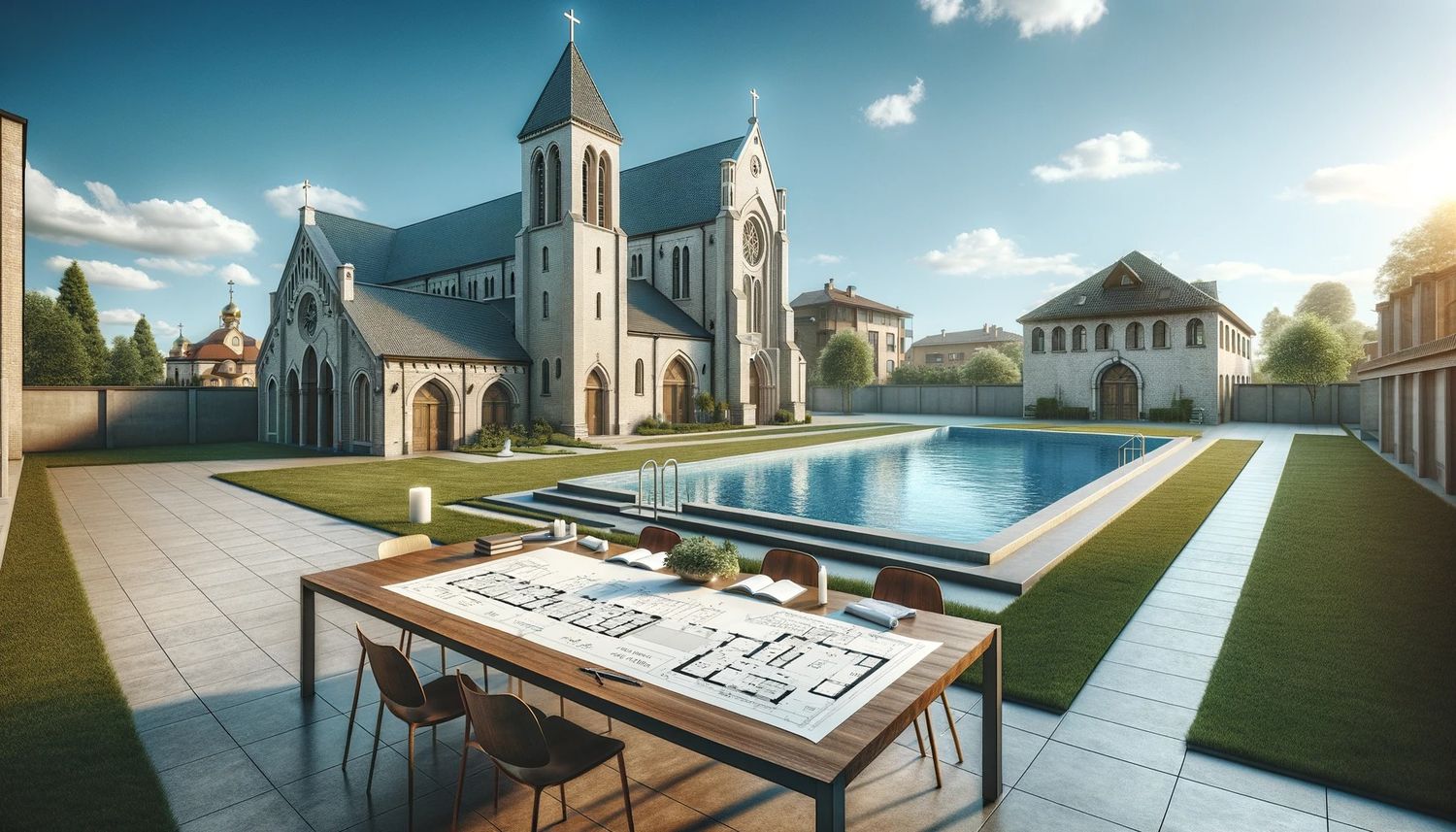Home>Theology and Spirituality>How To Build A Baptism Pool


Theology and Spirituality
How To Build A Baptism Pool
Published: February 29, 2024
Jason DeRose, Managing Editor at Christian.net, uses his expertise in religion and journalism to deepen understanding of faith's societal impacts. His editorial leadership, coupled with a strong academic background, enriches the platform’s diverse content, earning him recognition in both journalism and religious circles.
Learn how to build a baptism pool for your church or community. Discover the theology and spirituality behind creating a sacred space for baptism ceremonies.
(Many of the links in this article redirect to a specific reviewed product. Your purchase of these products through affiliate links helps to generate commission for Christian.net, at no extra cost. Learn more)
Table of Contents
Introduction
Are you looking to create a baptism pool for your church or religious community? Building a baptism pool is a significant undertaking, but with the right guidance and preparation, it can be a rewarding and spiritually fulfilling project. In this article, we will explore the step-by-step process of constructing a baptism pool, from planning and designing to adding the finishing touches. Whether you are a member of the clergy, a dedicated church volunteer, or simply someone passionate about religious practices, this guide will provide you with the essential knowledge to create a baptism pool that meets the needs of your congregation. Let's dive in and learn how to build a baptism pool that will serve as a sacred space for baptisms and spiritual renewal.
Read more: What Is The Baptism Pool Called
Planning and Designing Your Baptism Pool
When embarking on the journey of building a baptism pool, careful planning and thoughtful design are crucial. Here are the key steps to consider when planning and designing your baptism pool:
-
Consult with Religious Authorities: Before initiating the construction of a baptism pool, it is essential to consult with religious authorities or leaders within your faith community. Understanding the specific requirements and guidelines for baptismal pools within your religious tradition is fundamental. This may include the size, shape, and depth of the pool, as well as any specific religious or symbolic elements that should be incorporated into the design.
-
Assess Available Space: Evaluate the available space within your church or religious facility to determine the most suitable location for the baptism pool. Consider factors such as accessibility, visibility, and the overall aesthetic impact of the pool within the sacred space.
-
Design Considerations: Work with a professional designer or architect to create a detailed plan for the baptism pool. Consider the overall aesthetic of the pool, as well as practical elements such as drainage, accessibility for individuals with disabilities, and safety features.
-
Budget and Resources: Determine the budget and resources available for the construction of the baptism pool. Consider fundraising efforts or seeking donations from members of the congregation to support the project.
-
Permits and Regulations: Research and obtain any necessary permits or approvals required for the construction of a baptism pool within your local jurisdiction. Ensure compliance with building codes, safety regulations, and health standards.
By carefully planning and designing your baptism pool, you can lay the foundation for a sacred space that will serve as a meaningful site for baptisms and spiritual reflection within your religious community.
Choosing the Right Location
Selecting the optimal location for your baptism pool is a critical decision that will significantly impact its functionality and symbolic significance within your religious space. Here are essential considerations when choosing the right location for your baptism pool:
-
Accessibility and Visibility: Ensure that the location of the baptism pool allows for easy accessibility for individuals participating in the baptism ceremony. Additionally, consider the visibility of the pool within the sacred space, as it should serve as a focal point for the congregation during baptisms and other religious rituals.
-
Aesthetic Harmony: The location of the baptism pool should harmonize with the overall aesthetic and architectural elements of your church or religious facility. It should complement the existing design while also standing out as a symbol of spiritual significance.
-
Proximity to Sanctuary or Worship Area: Consider locating the baptism pool in close proximity to the sanctuary or worship area, allowing for a seamless transition from the baptism ceremony to other religious activities. This proximity reinforces the connection between the act of baptism and the spiritual life of the congregation.
-
Practical Considerations: Evaluate practical aspects such as plumbing accessibility, drainage, and the potential impact of the baptism pool on existing infrastructure. Additionally, consider the availability of natural light and the overall ambiance of the chosen location.
-
Symbolic Significance: Reflect on the symbolic significance of the chosen location within the context of your religious tradition. The placement of the baptism pool should align with any specific religious symbolism or theological significance associated with the act of baptism.
By carefully considering these factors, you can select a location for your baptism pool that enhances the spiritual experience of baptisms and fosters a sense of reverence within your religious community.
Gathering Materials and Tools
Gathering the necessary materials and tools is a crucial step in the construction of a baptism pool. Here's a comprehensive list of the essential items you will need to bring your vision of a baptismal pool to life:
Materials
- Concrete: The primary material for constructing the walls and floor of the baptism pool.
- Rebar: Reinforcing steel bars to provide structural strength to the concrete.
- Waterproofing Membrane: A durable membrane to prevent water leakage and ensure the longevity of the baptism pool.
- Plumbing Fixtures: Including pipes, drains, and fittings for the water supply and drainage system.
- Filtration System Components: Such as pumps, filters, and sanitation equipment to maintain water quality.
- Tiles or Finish Materials: For the aesthetic finishing of the baptism pool.
Tools
- Excavation Equipment: Such as a backhoe or excavator for digging the foundation of the baptism pool.
- Concrete Mixing Equipment: Including a concrete mixer and tools for pouring and leveling the concrete.
- Rebar Cutters and Benders: Essential for preparing and shaping the reinforcing steel bars.
- Waterproofing Application Tools: Brushes, rollers, and sprayers for applying the waterproofing membrane.
- Plumbing Tools: Wrenches, pipe cutters, and other tools for installing the plumbing fixtures.
- Tiling Tools: If using tiles for the finishing, tools for cutting and setting the tiles.
By ensuring that you have all the necessary materials and tools at your disposal, you can proceed with confidence in the construction of the baptism pool, knowing that you are well-prepared to bring this sacred space to fruition.
Building the Foundation
The foundation of a baptism pool is the cornerstone of its structural integrity and longevity. Building a solid foundation requires careful planning and precise execution. Here's a detailed guide on how to build the foundation for your baptism pool:
-
Excavation: Begin by excavating the area where the baptism pool will be located. Use excavation equipment such as a backhoe or excavator to dig a hole that corresponds to the dimensions and depth specified in your design plan. Ensure that the excavation is carried out with precision to achieve the desired shape and depth for the foundation.
-
Compaction: Once the excavation is complete, the soil at the bottom of the hole should be thoroughly compacted to create a stable base for the foundation. Use compaction equipment to achieve the required level of soil compaction, ensuring that the foundation will be able to support the weight of the baptism pool and its contents.
-
Rebar Installation: After the compaction of the soil, it's time to install the reinforcing steel bars (rebar) that will provide structural strength to the foundation. Place the rebar in a grid pattern according to the specifications outlined in your design plan. Secure the rebar in place to ensure it remains in the correct position during the concrete pouring process.
-
Formwork Construction: Construct formwork around the perimeter of the excavation to contain the concrete that will be poured to create the foundation. The formwork should be built to the precise dimensions and shape of the foundation, ensuring that it is level and securely braced to withstand the pressure of the concrete.
-
Concrete Pouring: With the formwork in place and the rebar secured, it's time to pour the concrete to create the foundation of the baptism pool. Use a concrete mixer to prepare the concrete mixture according to the recommended specifications. Pour the concrete into the formwork, ensuring that it is distributed evenly and compacted to eliminate air pockets.
-
Leveling and Finishing: Once the concrete has been poured, use leveling tools to ensure that the surface of the foundation is even and smooth. Pay attention to the edges and corners, ensuring that they are well-defined and aligned with the design plan. Allow the concrete to cure according to the recommended timeline before proceeding with the construction of the walls and floor of the baptism pool.
By following these steps with precision and attention to detail, you can establish a strong and durable foundation for your baptism pool, setting the stage for the successful completion of this sacred structure.
Constructing the Walls and Floor
Constructing the walls and floor of a baptism pool is a pivotal phase in the overall construction process, as it defines the structure's form and functionality. Here's a comprehensive guide on how to effectively construct the walls and floor of your baptism pool:
Formwork Preparation
Before commencing the construction of the walls and floor, it is essential to prepare the formwork. The formwork serves as a mold for the concrete, shaping it into the desired structure. Carefully construct the formwork to match the dimensions and contours specified in the design plan. Ensure that the formwork is securely braced and aligned to prevent any misalignment or deformation during the concrete pouring process.
Reinforcement Placement
Once the formwork is in place, it's time to position the reinforcement within the structure. Utilize reinforcing steel bars (rebar) to provide structural strength to the walls and floor of the baptism pool. Follow the design plan to determine the appropriate placement and spacing of the rebar, ensuring comprehensive coverage and support within the concrete structure.
Concrete Mixing and Pouring
Prepare the concrete mixture according to the recommended specifications, taking into account the required strength and durability for the walls and floor of the baptism pool. Use a concrete mixer to achieve a consistent and well-blended concrete mixture. Carefully pour the concrete into the formwork, ensuring that it fills all the designated areas and completely envelops the reinforcement. Employ proper compaction techniques to eliminate air pockets and achieve a dense, uniform concrete structure.
Finishing and Curing
After the concrete has been poured, focus on finishing the walls and floor to achieve a smooth and uniform surface. Utilize trowels and other finishing tools to eliminate imperfections and create a visually appealing texture. Pay particular attention to the edges and corners, ensuring that they are well-defined and free from any irregularities. Once the concrete has been finished, allow it to cure according to the recommended timeline, providing the necessary time for it to achieve its full strength and stability.
Waterproofing and Sealing
To ensure the longevity and integrity of the baptism pool, it is crucial to apply a waterproofing membrane to the walls and floor. The waterproofing membrane acts as a protective barrier, preventing water leakage and safeguarding the concrete structure from moisture-related damage. Apply the waterproofing membrane according to the manufacturer's instructions, ensuring comprehensive coverage and a secure seal.
By meticulously following these steps, you can effectively construct the walls and floor of your baptism pool, creating a durable and aesthetically pleasing structure that will serve as a sacred space for baptisms and spiritual renewal within your religious community.
Read more: How To Do A Baptism
Installing the Filtration System
Installing a reliable filtration system is essential to maintain the water quality and cleanliness of the baptism pool. Here's a detailed guide on how to effectively install the filtration system:
Selecting the Filtration Equipment
Begin by selecting the appropriate filtration equipment for your baptism pool. Consider factors such as the size of the pool, the anticipated volume of water, and the specific filtration requirements based on the usage patterns and frequency of pool maintenance. Common filtration components include pumps, filters, and sanitation equipment.
Plumbing Installation
Install the necessary plumbing fixtures to facilitate the operation of the filtration system. This includes connecting the filtration equipment to the water supply and establishing the drainage system. Ensure that the plumbing installation complies with relevant building codes and safety standards, and that it is designed to effectively circulate and filter the water within the baptism pool.
Filtration Equipment Placement
Position the filtration equipment in a designated area adjacent to the baptism pool. Ensure that the equipment is securely anchored and protected from environmental elements. Consider factors such as accessibility for maintenance and the overall aesthetic impact on the surrounding area.
Read more: How To Conduct A Baptism?
Electrical Connection
If the filtration equipment requires electrical power, ensure that it is properly connected to a reliable power source. Adhere to electrical safety protocols and consider consulting a qualified electrician to ensure the proper installation and grounding of the electrical components.
Testing and Calibration
Once the filtration system is installed, conduct thorough testing and calibration to ensure that it is functioning optimally. Test the flow rate, filtration efficiency, and water circulation to verify that the system meets the required performance standards. Make any necessary adjustments to achieve the desired filtration outcomes.
Maintenance and Operation Guidelines
Provide comprehensive maintenance and operation guidelines for the filtration system to the individuals responsible for its upkeep. This includes regular inspection, cleaning, and servicing of the filtration equipment to maintain its efficiency and prolong its lifespan. Educate relevant personnel on the proper operation of the system and the protocols for addressing any potential issues or malfunctions.
By following these steps, you can effectively install a reliable filtration system for your baptism pool, ensuring that the water remains clean, clear, and conducive to the sacred act of baptism.
Filling and Testing the Baptism Pool
Filling and testing the baptism pool is a crucial phase that ensures the readiness and functionality of the sacred space for baptisms and spiritual ceremonies. Here's a detailed guide on how to effectively fill and test the baptism pool:
Read more: How To Prepare For Baptism
Water Filling Process
-
Water Source: Identify a reliable and clean water source for filling the baptism pool. Ensure that the water meets the necessary quality standards and is free from contaminants that could compromise the sanctity of the pool.
-
Filling Protocol: Establish a systematic protocol for filling the baptism pool with water. Consider factors such as the required water level, the rate of filling, and any specific procedures or blessings that may be incorporated into the filling process based on religious traditions.
-
Supervision and Observation: Assign responsible individuals to oversee the water filling process, ensuring that it proceeds according to the established protocol. Monitor the water level and quality throughout the filling process to address any potential issues promptly.
Water Testing and Treatment
-
Water Quality Analysis: Conduct comprehensive testing of the water to assess its quality and ensure that it meets the necessary standards for cleanliness and purity. Utilize water testing kits or engage professional services to analyze parameters such as pH levels, chlorine concentration, and microbial content.
-
Water Treatment: If the water quality does not meet the required standards, implement appropriate treatment measures to address any deficiencies. This may include adjusting the pH levels, adding sanitizing agents, or employing filtration and purification techniques to enhance water quality.
-
Sanitization and Disinfection: Prior to the baptism ceremony, ensure that the water in the pool undergoes thorough sanitization and disinfection to create a hygienic and safe environment for the individuals participating in the baptism.
Testing and Safety Checks
-
Filtration System Testing: Verify the functionality of the filtration system by conducting rigorous testing of its components. Assess the water circulation, filtration efficiency, and the overall performance of the system to ensure that it effectively maintains water quality.
-
Safety Inspections: Perform comprehensive safety inspections of the baptism pool, including the structural integrity of the walls and floor, the presence of safety features such as handrails or steps, and the absence of any potential hazards that could compromise the safety of individuals during the baptism ceremony.
-
Accessibility and Amenities: Confirm that the baptism pool and its surrounding area are accessible to individuals with diverse needs, including those with disabilities. Ensure the availability of amenities such as changing facilities, restrooms, and seating areas to accommodate the needs of participants and observers.
By meticulously following these steps, you can effectively fill and test the baptism pool, ensuring that it is prepared to serve as a sacred and spiritually significant space for baptisms and religious ceremonies within your community.
Adding Finishing Touches
The process of adding finishing touches to the baptism pool is a transformative phase that elevates the space to a sacred and visually captivating environment. Here's a detailed guide on how to add the essential finishing touches to your baptism pool:
Read more: How To Invite For Baptism
Aesthetic Enhancements
-
Decorative Tiles: Consider adorning the interior of the baptism pool with decorative tiles that reflect the spiritual significance of the space. Choose tiles that align with the aesthetic and symbolic elements of your religious tradition, incorporating colors and patterns that evoke a sense of reverence and sanctity.
-
Symbolic Elements: Integrate symbolic elements into the design of the baptism pool, such as religious motifs, mosaics, or inscriptions that convey the spiritual essence of the space. These elements serve to imbue the pool with deeper meaning and connect it to the religious heritage of your community.
Illumination and Ambiance
-
Lighting Design: Strategically plan the lighting around the baptism pool to create an ambiance that enhances the spiritual experience. Consider the use of soft, warm lighting that fosters a sense of tranquility and reverence, illuminating the pool area in a gentle and inviting manner.
-
Natural Elements: Incorporate natural elements such as plants, water features, or reflective surfaces that harmonize with the surroundings and contribute to a serene and contemplative atmosphere. These elements can further enrich the visual and sensory experience of the baptism pool.
Furnishings and Amenities
-
Seating and Observation Areas: Provide comfortable seating and observation areas for individuals attending baptism ceremonies. Consider the placement of benches, chairs, or designated viewing areas that allow participants and spectators to witness the baptisms while fostering a sense of community and support.
-
Amenities and Facilities: Ensure that the surrounding area of the baptism pool is equipped with amenities such as changing facilities, restrooms, and storage areas for ceremonial items. These amenities contribute to the overall comfort and convenience of individuals participating in or witnessing baptism ceremonies.
Landscaping and Surroundings
-
Landscaping Features: Enhance the surroundings of the baptism pool with thoughtful landscaping, incorporating elements such as gardens, pathways, or reflective spaces that complement the spiritual ambiance of the area. Consider the use of natural materials and greenery to create a tranquil and harmonious environment.
-
Architectural Integration: Integrate the baptism pool seamlessly into the architectural and landscape design of the surrounding area. Ensure that the pool harmonizes with the overall aesthetic of the religious facility, creating a cohesive and visually striking focal point within the sacred space.
By meticulously attending to these finishing touches, you can elevate the baptism pool into a sacred and visually captivating space that embodies the spiritual essence of baptisms and serves as a place of profound significance within your religious community.
Read more: How To Celebrate A Baptism
Conclusion
In conclusion, the construction of a baptism pool is a significant endeavor that requires careful planning, precise execution, and a deep understanding of the spiritual significance it holds within a religious community. By following the step-by-step process outlined in this guide, individuals and religious organizations can create a baptism pool that serves as a sacred space for baptisms and spiritual renewal. From the initial planning and design stages to the installation of the filtration system and the addition of finishing touches, each phase contributes to the creation of a space that honors the tradition of baptism and fosters a sense of reverence and spiritual connection. The completion of a baptism pool represents not only the physical manifestation of a sacred structure but also the embodiment of the spiritual values and beliefs that it represents within a religious community. As individuals gather to partake in the act of baptism within this consecrated space, they are met with an environment that reflects the sanctity and significance of the religious rituals being performed. Ultimately, the construction of a baptism pool is a testament to the enduring traditions and spiritual practices that continue to enrich the lives of individuals and communities, providing a place for profound moments of faith and spiritual transformation.








